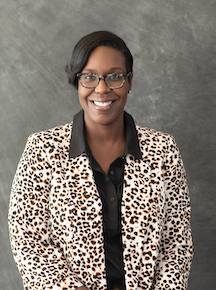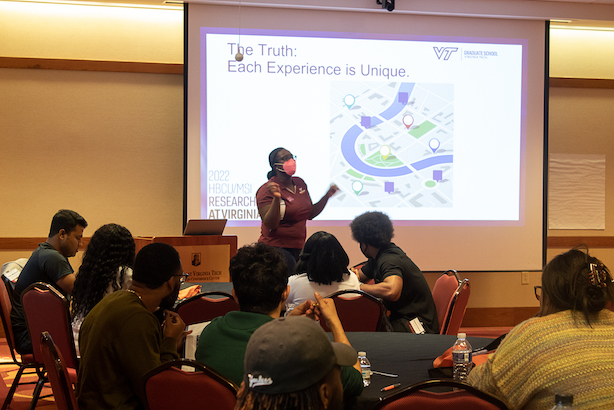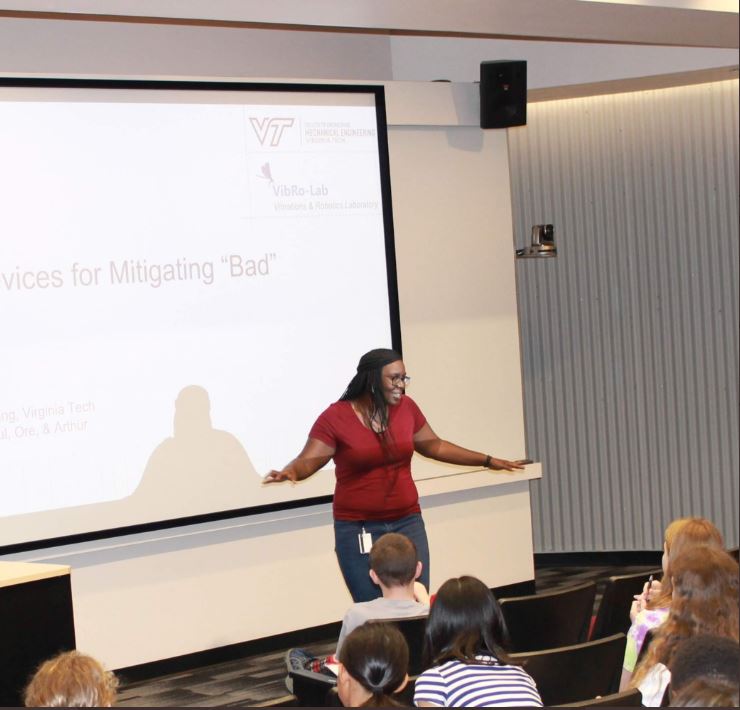
ASEE CDEI Scholar Spotlight Series: Shernita Lee
Dr. Shernita Lee
Dr. Shernita Lee is the Assistant Dean and Director of the Virginia Tech Graduate School’s Office of Recruitment, Diversity, and Inclusion. Dr. Lee’s training is in discrete computational biology but she also specializes in student engagement, programming, and outreach. She holds a bachelor’s degree in mathematics from Alabama State University and a doctorate from Virginia Tech in genetics, bioinformatics, and computational biology. She is passionate about creating a diverse and inclusive environment for graduate students, improving graduate student retention, aiding in the navigation of challenges graduate students encounter, and directing students to university/departmental resources and advocates to help them successfully complete their degree.
Q: Can you tell us your story of belongingness?

Dr. Shernita Lee
As someone who identifies as an African American woman from the South (Alabama), my belongingness is very much related to my culture. I currently work at the same institution where I was a graduate student. So, when I think of belongingness, the number one thing I’ve learned from navigating spaces as a Black woman that I try to share with my students is that I can’t make comparisons. I can’t try to make another space something that it isn’t. I must truly take it at face value. Because once that happens, I can work to make myself feel more comfortable and feel like I belong. That belongingness is sometimes dependent on others who also occupy that space. But with growth, time, education, and experience, I’ve learned how to operate in spaces independent of whether people who make me feel comfortable are present. Belongingness is an individual decision. There can be many strategies, events, and programs – all these things are great – but if a person has decided in their mind that they don’t fit in or feel comfortable, that space will never be one where they can thrive or see themselves. So, none of those measures will ever work. Therefore, belongingness is a mindset. And once a person is willing and open to different experiences and people, then that belonging can truly take place. One specific instance of my experiencing belongingness took place in graduate school. I was pursuing a computational science degree, not necessarily engineering, but a stem discipline, nonetheless. Initially, I hated being away from home, from family and friends, and things that were comfortable to me. I also attended a historically Black college and university. So, I was used to being in a space where everyone looked like me. Again, I had to shed that layer of expectation of visual community and instead look for similarities in values and interests and move beyond those identities that are visible to the naked eye. During graduate school, I traveled back and forth from Virginia to Alabama constantly. Finally, my mom asked, “Are you going to keep coming home every weekend?” I soon recognized that traveling so frequently wasn’t viable for a graduate student’s budget, but I also realized that a PhD was something I wanted to pursue. I knew that if I wanted to complete my degree, I had to figure out how to make the space work for me because I’m most productive in spaces where I feel comfortable. Once that light bulb moment happened, where I could turn on that switch, that was when I was really able to thrive and felt like I belonged.
Q: What is your understanding of DEI and why it is important to what you do?
 My understanding of DEI is always changing and evolving. The strategies and methods I would’ve used in 2019 are much different than what I had to do in 2020 and so forth. Similarly, as we are starting off 2023, there are different things that I have in mind about it as well. My understanding of DEI is thinking about the diversity of individuals related to their different identities. Over time, I have strived to look beyond visual identities and help students thrive in those invisible identities. For instance, working with students who were recently diagnosed with autism, ADHD, or are on the spectrum has challenged me to help them figure out how they can still thrive in graduate school when all these changes are happening in their personal lives. I like to be flexible in my understanding of DEI. I sometimes think DEI has been limited in ways or oversimplified, which has discounted its value to some students. My understanding of DEI is correlated to my personal experiences, as well as the experiences of students and others that I’ve been able to encounter. It’s essential to what I do because my role is focused on DEI, recruitment, and retention. Without that DEI understanding or willingness to learn from others and make mistakes, then I wouldn’t be able to perform my job to the best of my ability. I recall one time when I was giving a DEI talk to several hundred students. As I left the stage at the end of my presentation, someone came up to me and mentioned that I used a phrase about individuals who might have a disability that she would have rephrased. This situation made me realize that while you can have this knowledge base or the confidence to operate and function in this space, you must be receptive to feedback and criticism and use them as growing moments to be a better trainer, educator, teacher, researcher, etc.
My understanding of DEI is always changing and evolving. The strategies and methods I would’ve used in 2019 are much different than what I had to do in 2020 and so forth. Similarly, as we are starting off 2023, there are different things that I have in mind about it as well. My understanding of DEI is thinking about the diversity of individuals related to their different identities. Over time, I have strived to look beyond visual identities and help students thrive in those invisible identities. For instance, working with students who were recently diagnosed with autism, ADHD, or are on the spectrum has challenged me to help them figure out how they can still thrive in graduate school when all these changes are happening in their personal lives. I like to be flexible in my understanding of DEI. I sometimes think DEI has been limited in ways or oversimplified, which has discounted its value to some students. My understanding of DEI is correlated to my personal experiences, as well as the experiences of students and others that I’ve been able to encounter. It’s essential to what I do because my role is focused on DEI, recruitment, and retention. Without that DEI understanding or willingness to learn from others and make mistakes, then I wouldn’t be able to perform my job to the best of my ability. I recall one time when I was giving a DEI talk to several hundred students. As I left the stage at the end of my presentation, someone came up to me and mentioned that I used a phrase about individuals who might have a disability that she would have rephrased. This situation made me realize that while you can have this knowledge base or the confidence to operate and function in this space, you must be receptive to feedback and criticism and use them as growing moments to be a better trainer, educator, teacher, researcher, etc.
Q: Briefly explain the current initiatives that you are doing towards DEI.
 One arm of the projects that I work on is related to the educational component of DEI. My institution has an inclusion and diversity requirement for all graduate students, which must be satisfied to graduate. I manage that process and work with the different departments and programs to ensure that they have a plan that addresses all the core components of that requirement. Now, I’m working on initiatives with our institution’s Diversity Scholars, which are students that are focused on different projects or ideas they have as it relates to diversity. I think many students have their own experiences, and they know what isn’t right with institutions. So, I work with students to look beyond the flaws and think instead about solutions and steps we can take to make progress. I’m also currently teaching a course, Diversity for Global Society, which hosts students from various departments, like engineering, veterinary medicine, and animal science. Students being in this space together allows them to learn and grow from one another and have those uncomfortable conversations. It’s rare that you can hear someone share insight about a statement someone made ten years ago that still hurts them today. And there may be someone in the class – they may not speak up on it – who recognizes how their actions could have potentially impacted others. So, it encourages them to develop a deeper level of understanding, thereby creating a newer and better generation of leaders, scientists, and researchers.
One arm of the projects that I work on is related to the educational component of DEI. My institution has an inclusion and diversity requirement for all graduate students, which must be satisfied to graduate. I manage that process and work with the different departments and programs to ensure that they have a plan that addresses all the core components of that requirement. Now, I’m working on initiatives with our institution’s Diversity Scholars, which are students that are focused on different projects or ideas they have as it relates to diversity. I think many students have their own experiences, and they know what isn’t right with institutions. So, I work with students to look beyond the flaws and think instead about solutions and steps we can take to make progress. I’m also currently teaching a course, Diversity for Global Society, which hosts students from various departments, like engineering, veterinary medicine, and animal science. Students being in this space together allows them to learn and grow from one another and have those uncomfortable conversations. It’s rare that you can hear someone share insight about a statement someone made ten years ago that still hurts them today. And there may be someone in the class – they may not speak up on it – who recognizes how their actions could have potentially impacted others. So, it encourages them to develop a deeper level of understanding, thereby creating a newer and better generation of leaders, scientists, and researchers.
Q: What do you see as the next steps for your DEI work?
I’ve been in my role for five years now. The programmatic piece is great, and I feel like that’s solid across the whole institution, not just my own department. But what I’m seeking to move towards with DEI work is having intentional relationships and strategic partnerships, where it’s not simply reciprocal communication of saying, “yes, we support you.” Instead, I’m looking for more financial support. While institutions overall have some funds dedicated to DEI, the needs of the students definitely far exceed the budget or capability of some units. To me, DEI work should be tied to fundraising, donations, and advancement because we have students who truly are struggling financially. They may be struggling due to a disposition just based on some of those identities they possess, or they could be coming to grad school with two kids, and their partner is in another country. So, considering my work as it intersects with recruitment and retention, I believe a solution to many of these problems is an institution’s commitment to planning and funding these initiatives. I think making progress towards that would alleviate a lot of stress and dissatisfaction some students have. So, I think expansion is my quick answer about the next steps for my DEI work. I’ve collaborated and talked to many others with DEI roles, and from their experiences and mine, we’ve all agreed that institutional and external support would be beneficial.

Q: What recommendations do you have for engineering educators to start incorporating social justice topics in their classrooms?
One recommendation I have is not to flip the switch completely overnight. It should be a gradual process. As an educator myself, I understand that each group of students, each cohort, is different. So, I think allowing yourself that time to really develop that curriculum, develop that lesson plan, and make a well-informed decision about what book or activity you want to incorporate into the curriculum to benefit your students. I think you need to take time to implement these topics carefully because students may observe or recognize your weaknesses related to these issues if you aren’t well-versed in them. Once that happens, you can lose confidence, which might make you reconsider incorporating these topics in your classroom in the future. Another recommendation I have is to think of creative ways for students to lead discussions on these topics. For example, I proposed an assignment for my graduate students where it was their responsibility to pick the topics for our class discussions. I required them to lead one or two of them during the semester, and it helped them become more comfortable speaking publicly and sharing their thoughts. It also allows students to realize that others may be dealing with similar problems as them. I would encourage people to think outside of the box and figure out what their objectives are for incorporating social justice into their classroom. Really think through what you want to accomplish. What would success look like for you if you could incorporate even a few of those topics? A final recommendation or tip I have is to reach out to experts in a topic to lead discussions in your courses because it can alleviate pressure from you as the instructor. Use your resources, and if you don’t have a network of individuals who you think would be good for that opportunity, this would be a great time to expand your network and find those individuals.
Q: What resource can you recommend to people who want to learn more about DEI in your field?
I would encourage people to join or participate in professional diversity-related organizations. Some of those are specifically tied to certain identity groups. Others might be related to the discipline or the field. So, do your research and figure out what those organizations are. Many offer free or reduced membership rates for students, so it’s definitely worthwhile; even if you’re early career, they also offer great benefits. Other resources you should take advantage of are centers focused on diversity in teaching and learning. These places can help educators tailor their learning material to different audiences and contexts, thus eliminating the pressure on educators to create their material from scratch. Another resource people should utilize is their personal network. Social media like LinkedIn is great for exploring people’s backgrounds with DEI roles to see what material they published and find frameworks for ideas within DEI that align with your own. For example, during the pandemic, I received a few messages on LinkedIn from someone with a doctorate. They were older and came into the DEI space from a business perspective. Since my background is in STEM, some of our ideas didn’t align. Nevertheless, I invited this person to my class to speak because his perspective as a 60-year-old Black man could be valuable for students. I think it’s important to provide a space for my students to be able to learn about other ideas and experiences that are different from my own. They need to be exposed to different viewpoints to remove the stigma that we all have the same definition of diversity because recognizing this fact is an essential part of taking the next step toward having a truly diverse and inclusive space.
Recommended papers from our scholar on ASEE Peer:
Connect with our scholar:
ASEE CDEI Communications Committee Volunteers
Volunteer Webmaster: Sarah Lester, California Polytechnic State University
ASEE CDEI Spotlight Committee Volunteer
Getting involved with CDEI
- If you want to recommend someone for our Spotlight series click here.
- Check out website Highlights:
- Resources
- Past Blogs and Events
- Compilation of Newsletters and Reports
- Connect with the committee:
- Become a Friend of the Committee
- Follow us and tag us on Twitter
- Become a volunteer on our Communications Committee! We are always looking for people that want to share or improve their writing and leadership skills.
